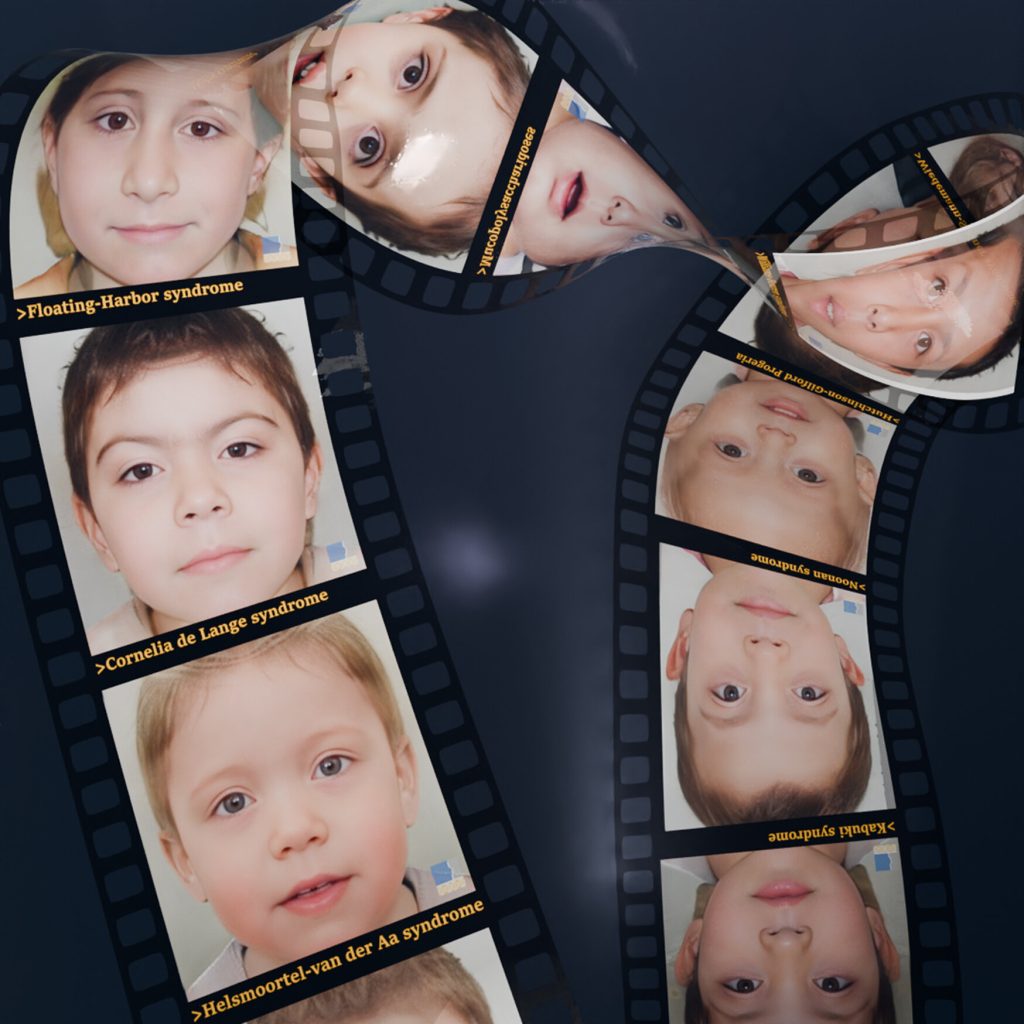Photorealistic synthetic portraits of different diseases diagnosed in a research context. Images were generated with GestaltGAN and do not allow drawing conclusions about individuals. Credit: Aron Kirchhoff, University Hospital Bonn (UKB)
The majority of rare diseases have a genetic cause. The underlying genetic mutations are increasingly easier to find, for example by exome sequencing (ES), leading to a molecular genetic diagnosis. ES examines all sections of the genetic material (DNA) that code for proteins. As part of a German-wide multicentre study, ES data were collected and systematically evaluated from 1,577 patients.
This allowed a total of 499 patients to be diagnosed, of which 34 patients presented with new previously unknown genetic disorders. This work represents a major contribution to the early description of new diseases. Furthermore, for the first time, artificial intelligence (AI)-based software was used extensively to assist diagnosis. Clinical diagnosis.’
The “GestaltMatcher” AI system can help evaluate facial features for classification of congenital genetic syndromes. The results of the study, which involved 16 universities, Published in Nature Genetics.
Treating ultra-rare diseases requires both multidisciplinary clinical expertise and comprehensive genetic diagnostics. The three-year TRANSLATE NAMSE Innovation Fund project was launched at the end of 2017 with the aim to improve patient care with modern diagnostic concepts.
Researchers from 16 university hospitals analyzed ES data from 1,577 patients, including 1,309 children, who visited rare disease centers as part of TRANSLATE NAMSE. The aim of the project is to use innovative testing methods to find the cause of disease in as many patients as possible.
a Genetic causes Mutations for this rare disease were identified in 499 patients, including 425 children. In total, the researchers found changes in 370 different genes.
“We are particularly proud of the discovery of 34 new molecular diseases. This is a great example of knowledge-generating patient care at the University Hospital,” says Dr. Theresa Brunet, one of the lead authors from the Institute of Human Genetics at the Isar Institute of Forensic Medicine of the Technical University of Munich.
What happens next with these unsolved cases?
“As part of the model project ‘Genome Sequencing’ (MVGenomSeq for short), we will test affected patients who have not yet been diagnosed,” says Dr. Tobias Hack, deputy director of the Institute of Medical Genetics and Applied Genomics at the University Hospital Tübingen.
MVGenomSeq builds on the success of the TRANSLATE NAMSE project and enables the analysis of clinical genomes in university hospitals across Germany. Unsolved cases can also be investigated in follow-up studies using new testing methods such as long-read sequencing, which allows the analysis of much longer DNA fragments.
“Long-read sequencing allows us to find genetic changes that are hard to detect and we think that this method could be used to enable further diagnostics,” said Dr. Nadja Emke, head of the Genomic Diagnostics Department at Charité’s Institute of Medical Genetics and Human Genetics and one of the study’s final authors.
As part of the TRANSLATE NAMSE project, participating rare disease centers also established standardized procedures for extended genetic diagnostics for suspected rare diseases based on multidisciplinary case conferences. These were incorporated into the standard of care after the project was completed.
“Interdisciplinary case conferences play an important role for patients: they allow a comprehensive clinical characterization, which is relevant for the phenotype-based evaluation of the genetic data. Furthermore, the detected mutations can be discussed in an interdisciplinary context,” says Dr. Magdalena Daniel, one of the first authors, expert at the Institute of Medical Genetics and Human Genetics at the Charité University School of Medicine and fellow in the Clinician Scientist Programme at the Berlin Institute of Health (BIH).
Rare genetic disorder may be identifiable by face
The researchers also investigated whether the supplemental use of machine learning and artificial intelligence (AI) tools could improve the effectiveness and efficiency of diagnostics.
To this end, “GestaltMatcher”, software developed by researchers in Bonn that uses computer-assisted facial analysis to support people in diagnosing rare diseases, has been tested on a large scale for the first time.
The study used sequence and image data from 224 people who also consented to computer-assisted analysis of their facial images and demonstrated that AI-assisted technology can provide clinical benefit.
GestaltMatcher AI can recognize facial abnormalities and assign them to specific diseases. A key question when evaluating genetic data is: does the phenotype match the genotype? AI can provide support here.
“GestaltMatcher is like an expert opinion that can be provided to any medical professional in just a few seconds. Early diagnosis is essential for people suffering from rare diseases and their families. Supportive use of the software by paediatricians could already be helpful if abnormalities are found during the U7 screening at 21-24 months or the U7a screening at 34-36 months,” says corresponding author Prof. Peter Kravitz, Director of the Institute of Genomic Statistics and Bioinformatics (IGSB) at University Hospital Bonn (UKB), where GestaltMatcher AI is developed.
Professor Kravitz is also a member of the Cluster of Excellence ImmunoSensation2 at the University of Bonn and is affiliated with the Interdisciplinary Research Areas (TRA) “Modelling” and “Life & Health”. The software and app will be made available to all physicians through the non-profit organisation Arbeitsgemeinschaft für Gen-Diagnostik eV (AGD).
For more information:
Axel Schmidt et al. “Next-generation phenotyping integrated into a national framework for patients with ultra-rare diseases improves genetic diagnostics and provides novel molecular discoveries.” Nature Genetics (2024). DOI: 10.1038/s41588-024-01836-1
Provided by
Bonn University Hospital
Quote: Genetic diagnostics for ultra-rare diseases: Large-scale multi-center study identifies 34 new genetic disorders (July 22, 2024) Retrieved July 23, 2024 from https://medicalxpress.com/news/2024-07-genetic-diagnostics-ultra-rare-diseases.html
This document is subject to copyright. It may not be reproduced without written permission, except for fair dealing for the purposes of personal study or research. The content is provided for informational purposes only.


